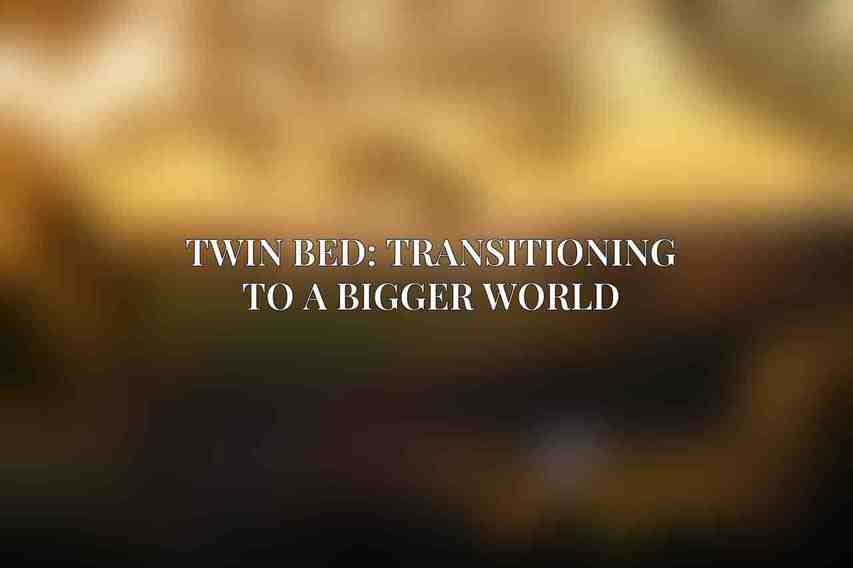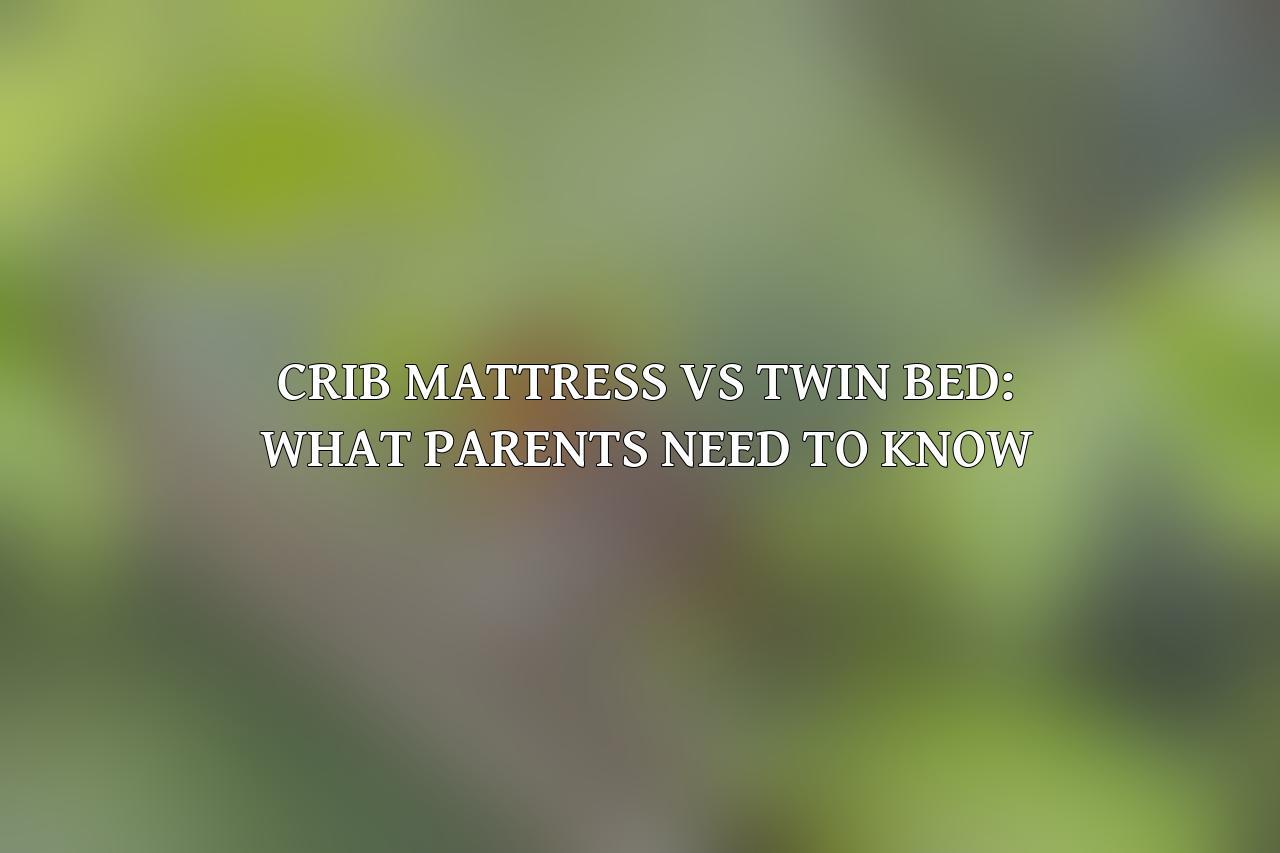The transition from a crib to a bed is a crucial milestone in a child’s life, signifying growth and independence. For parents, this shift comes with a myriad of considerations to ensure their child’s safety and comfort. This guide aims to explore the differences between crib mattresses and twin beds, providing parents with essential knowledge to make informed decisions.
| Feature | Crib Mattress | Twin Bed Mattress |
|---|---|---|
| Size | 52″ x 28″ | 39″ x 75″ |
| Thickness | 4-6″ | 6-10″ |
| Firmness | Very firm | Medium to firm |
| Material | Foam, innerspring, organic, hybrid | Foam, innerspring, memory foam, latex |
| Safety Features | Breathable, waterproof, hypoallergenic, non-toxic | Fire-retardant, stain-resistant, durable |
| Price | $100 $300 |
$100 $500 |
| Durability | Short-term (until toddler age) | Long-term (until teenager) |
| Examples | Best Crib Mattress |
Best Twin Bed Mattress |
Quick List :
- 1. Best Crib Mattress:
- 2. Best Twin Mattress:
- 3. Crib Mattress vs Twin Bed: What Parents Need to Know:
Crib Mattress: Safety and Comfort for the Little Ones
Size and Dimensions
- Standard crib mattresses typically measure 52″ x 28″ x 6″, offering a snug fit within the crib to prevent gaps that may pose entrapment risks.
- Firmness is a key feature of crib mattresses, designed to support the delicate spine of infants and reduce the risk of Sudden Infant Death Syndrome (SIDS).
- Ensuring proper fit is essential for safety, with an ill-fitting mattress increasing the chances of accidents and discomfort.
Materials and Features
- Cotton: Known for its softness, breathability, and hypoallergenic properties, making it gentle on the baby’s skin.
- Organic Cotton: Free from harmful chemicals and pesticides, ideal for babies with sensitive skin or allergies.
- Polyester: Durable and easy to clean, often blended with cotton for added strength and longevity.
- Foam: Available in varying densities, offering support and cushioning tailored to different firmness preferences.
- Innerspring: Providing a more traditional mattress feel, promoting airflow and support.
- Waterproof Cover: Safeguards the mattress from spills and accidents, facilitating easier cleaning.
- Breathable Cover: Promotes air circulation, preventing overheating and ensuring a comfortable sleeping environment.
Best Crib Mattress
Crib mattresses excel in safety and comfort for infants, boasting features like firmness, snug fits, and breathability to reduce risks while providing optimal support. They are durable, portable, and generally more affordable than twin beds, making them a practical choice for nurseries.
Pros:
1. Safety: Reduced SIDS and entrapment risks.
2. Comfort: Ideal support for infants.
3. Durability: Withstands frequent use.
4. Portability: Easy to move.
5. Affordability: Budget-friendly option.
Find more on In-depth Newton Crib Mattress Review
Cons:
1. Limited Lifespan: Suited only for infants and toddlers.
2. Smaller Size: May not accommodate a growing child’s needs.
Stay tuned for the comparison with twin beds in the next section.
Twin Bed: Transitioning to a Bigger World

Size and Dimensions
- Standard twin beds typically measure 39″ x 75″ x 6″, offering more space and freedom of movement for growing children.
- Various mattress heights allow for customization to fit different bed frames and accommodate personal preferences.
Materials and Features
- Innerspring: Providing traditional comfort and support with adequate ventilation.
- Memory Foam: Contouring to the body for pressure relief and enhanced comfort.
- Latex Foam: Naturally hypoallergenic, breathable, and durable.
- Gel-Infused Memory Foam: Combining the benefits of memory foam with cooling gel for a more comfortable sleep experience.
- Adjustable Height: Some twin mattresses offer height options for personalized comfort.
- Waterproof Cover: Shields the mattress from spills and accidents, simplifying cleaning routines.
- Dust Mite Resistant Cover: Ideal for children with allergies, reducing exposure to common allergens.
Best Twin Mattress
Twin beds cater to older children with a focus on extended lifespan, space, and a wide range of styles and materials to suit diverse preferences. While they offer more room for growth and customization options, twin beds may pose safety concerns for infants and come at a higher price point compared to crib mattresses.
Pros:
1. Larger Size: Provides ample space for growing children.
Learn more about Best Non-Toxic Crib Mattresses for a Safe Sleep
2. Longer Lifespan: Suitable for many years.
3. Variety of Styles: Offers choices based on comfort and budget preferences.
Cons:
1. Less Safe for Infants: Not recommended due to safety hazards.
2. Higher Cost: Generally more expensive.
3. Bulkier: Challenging to move and transport.
We will delve into the factors to consider when choosing between a crib mattress and a twin bed, emphasizing safety, comfort, and practicality in the decision-making process.
Factors to Consider When Choosing Between a Crib Mattress and a Twin Bed
Child’s Age and Development
- Crib mattresses suit infants and toddlers up to approximately 3 years old.
- Twin beds are ideal for children who have outgrown their cribs and require more space.
Space and Budget
- Crib mattresses are compact and cost-effective options for nurseries.
- Twin beds demand more space and come at a higher price point.
Safety
- Crib mattresses prioritize safety with firm support and snug fits.
- Twin beds require attention to safety features to ensure stability and mattress firmness.
Comfort and Preferences
- Crib mattresses focus on infant support, while twin beds offer a broader range of comfort options.
The choice between a crib mattress and a twin bed hinges on various factors, including the child’s age, safety requirements, space availability, and budget constraints. By conducting thorough research and weighing the considerations discussed in this guide, parents can confidently select the most suitable sleeping option for their child’s well-being and development. Embracing this journey of transition with informed decisions fosters a safe and comfortable sleeping environment, nurturing growth and quality rest for children.
Frequently Asked Questions
1. What is the difference between a crib mattress and a twin bed?
A crib mattress is designed for infants and toddlers, fitting into a crib, while a twin bed mattress is larger and meant for older children or adults.
2. When should a child transition from a crib mattress to a twin bed?
Most children transition to a twin bed between the ages of 2-4, depending on their size and development.
3. Are crib mattresses and twin bed mattresses interchangeable?
No, crib mattresses are smaller and thinner to fit in a crib, while twin bed mattresses are larger and thicker for growing children.
4. Are there safety considerations parents need to be aware of when transitioning to a twin bed?
Yes, parents should ensure the twin bed is at a safe height and securely assembled to prevent falls and injuries.
Check this blog on When to Lower Your Baby’s Crib Mattress: Safety Guidelines
5. What are the pros and cons of using a crib mattress versus a twin bed for young children?
Pros of a crib mattress include fitting in a smaller space and being cost-effective, while a twin bed offers longevity and comfort for growing children.

